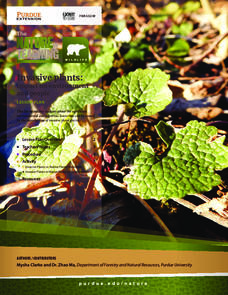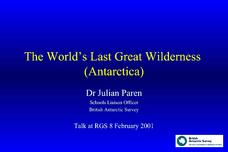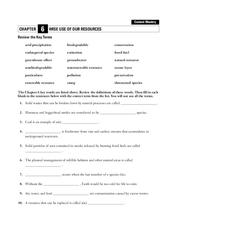Purdue University
Healthy Water, Happy Home
Clear water does not mean clean water. A collaborative lesson has groups play a board game to identify sources of water pollution and develop strategies for improving water quality. Their investigations include reference to the water...
Purdue University
Discovering the Watershed
Human impact on watersheds can make or break an ecosystem. Learners use a game to learn about the impact human choices have on water quality and the organisms that depend on it. The activity includes a game board and game cards that tell...
Purdue University
Coloration Exploration
Finding an animal in nature can be like a game of hide and seek. A thorough lesson explores different coloration strategies of animals. Pupils complete look-and-find puzzles and coloring sheets to differentiate between different types of...
Purdue University
Invasive Plants: Impact on Environment and People
It's the attack of the invasive species! Young scientists simulate the behavior of an invasive species with a game-like activity. They assume the roles of native plants, invasive plants, and resources and watch the invasive plant takes...
American Museum of Natural History
The Legend of the Flying Frog
Young conservation biologists have an opportunity to get involved in the effort to save endangered species. After reading and illustrating the tale of the Flying Frog, they craft a tale about another fictional endangered species.
Curated OER
Wildlife, Wolves, Endangered Species
Middle schoolers use the Internet to research wildlife and conservation efforts. They examine pictures and graphics to research endangered species and humans role in their lives. They also use math to measure areas of habitats and add...
Curated OER
Outdoor Education
Students participate in various outdoor activities to teach them about the environment. In this outdoor education lesson plan, students participate in activities such as compass direction, conservation, forestry, wildlife, and...
Curated OER
Parched! No Water, No Town
Young scholars discuss the benefits of water conservation. Given a data sheet, they document their water usage over a specified period. Water usage data is graphed and analyzed. Students discuss ways in which they can conserve water.
Curated OER
Mud in the Water
Young scholars build a soil erosion model to study the importance of soil conservation. They investigate how land forms from both constructive and destructive forces.
Curated OER
Panther Scavenger Hunt
Pupils research the Internet to fill out their scavenger hunt sheet. In this research lesson students search the Internet for answers to the questions on the scavenger hunt worksheet.
Curated OER
Cartoons for the Classroom: Conserve More or Drill More?
In this current events worksheet, students analyze a political cartoon about oil drilling and respond to 3 talking point questions.
Curated OER
Please Help!
Sixth graders examine the prairie food chain while designing a rescue strategy for an endangered species. They compare their strategy to that of a professional conservation expert.
Curated OER
Human Footprint
Students study facts about humans and how they are impacting the Earth. In this investigative lesson students help map peoples footprints over the Earth's surface and evaluate these factors.
Curated OER
Why the Y2Y?
Students investigate the proposed route from Yellowstone to Yukon. They listen to lectures about the proposal and the different opinions concerning it. Students research the type of wildlife in the area for the road and they consider how...
Curated OER
Wild Dog Urine
Students investigate biology by researching wild animals. In this animal extinction lesson, students research African wild dogs and discuss the impact of the environment on their survival. Students read and analyze an article titled...
Curated OER
The World's Last Great Wilderness (Antarctica)
It's a shame that there are no photographs in this presentation because the information is fascinating! Each identically fashioned slide contains bullet points of information about Antarctica that will enhance an earth science...
Curated OER
Legend of The Lorax
Students explore ecosystems. They read or listen to Dr. Seuss' The Lorax to draw conclusions and make predictions about the environmental impact and use of resources. They write poems about real forests and the wildlife which inhabit...
Curated OER
Postcards from the Edge: Endangered Species
Students use the internet to identify the endangered species in their state. Using this information, they create a postcard with a picture of the animal along with facts. They discuss the main reasons to protect the endangered species...
Curated OER
Marjory Stoneman Douglas
Students explore Marjory Stoneman Douglas and her contribution to the ecosystems and National Parks.
Curated OER
Wise Use of Our Resources
In this resource review worksheet, middle schoolers will review the definition of key vocabulary words and then fill in the blank with the correct term in 10 sentences.
Curated OER
Illegal coffee threatens wildlife
Young scholars, after reading an article from the World Wide Fund for nature on coffee possibly being grown illegally in an Indonesian national park and being sold to major coffee brands, answer several worksheets to text questions about...
Association of Fish and Wildlife Agencies
Schoolyard Biodiversity Investigation Educator Guide
In 1980, in the tropical rainforests of Panama, scientists discovered 1,200 species of beetles living in and around just 19 trees, with most of the species new to science—that's biodiversity! In the activity, learners work in teams to...
American Museum of Natural History
Theodore Roosevelt's Outdoor Adventures
Time for a virtual sightseeing trip. Pupils explore the Grand Canyon, Devil's Tower, and Yosemite Valley in an interactive online experience. They answer questions about the organisms in each location and draw conclusions based on their...
Curated OER
Backyard Habitats
Students identify habitat elements. They create a habitat in a backyard, on a balcony, at a workplace, or in a schoolyard and provide the four basic requirements of wildlife survival (food, water, cover, and places to raise young). They...

























